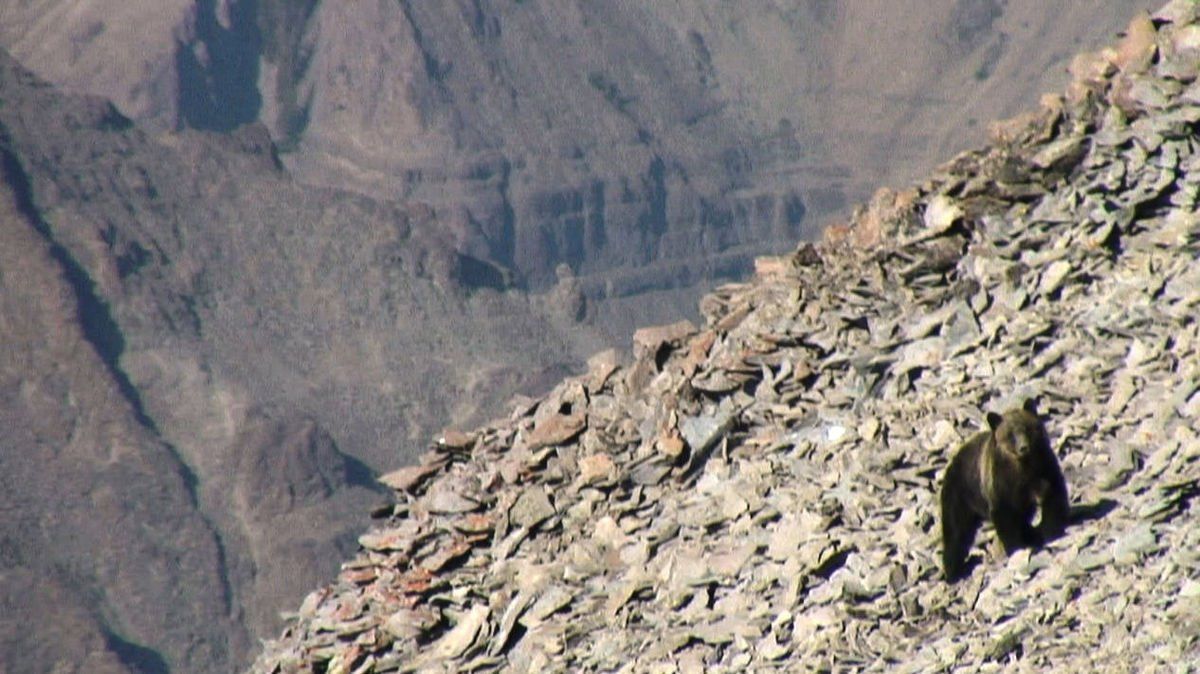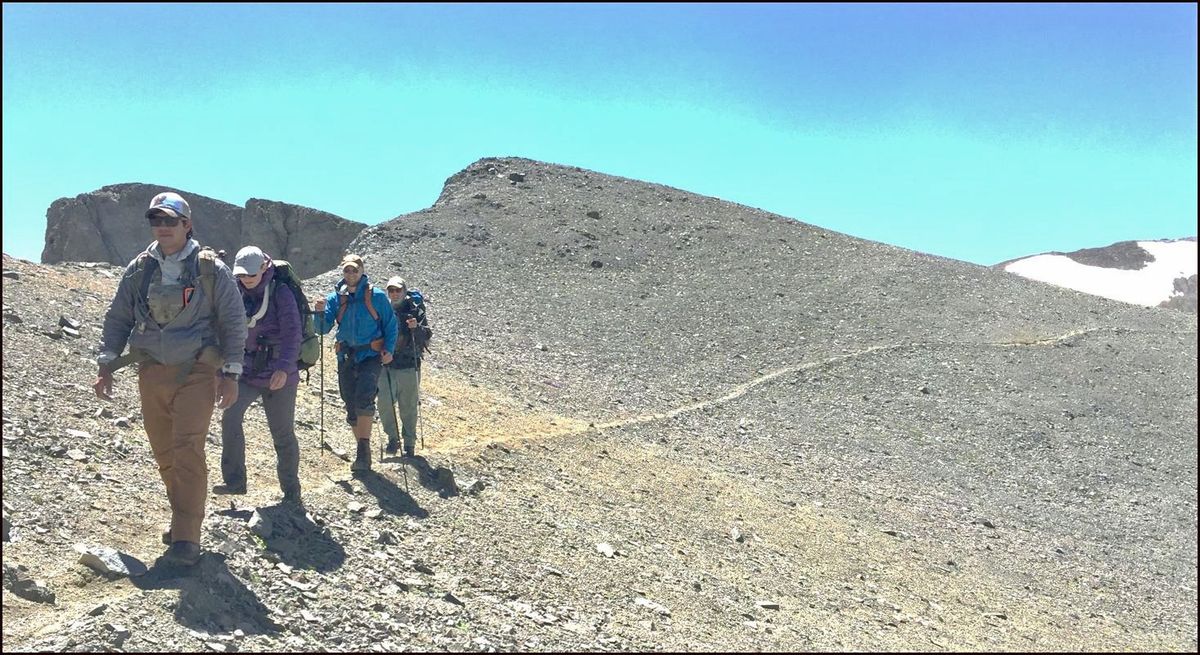Forest studies human pressure on grizzly bear high elevation feeding sites where moths congregate
Rocky slopes like this one are where grizzlies and other animals seek out the moths as a food source. The moths need a cool, moist environment to survive. (IGBST photo)
BILLINGS – Even on steep mountain slopes above 11,000 feet, hikers in the Greater Yellowstone Ecosystem are bumping into grizzly bears – sometimes intentionally.
In the middle of summer, some of the big bruins are scouring rocky inclines in search of a high-calorie food source, army cutworm moths. The moths hide in the cool shade of the stones in large congregations that can attract up to 50 bears feeding relatively close together. The humans are either attempting to summit a peak, often unaware of the grizzlies’ presence, or deliberately seeking the assembled bears to photograph, film and observe.
In response to this possibly hazardous intersection of man and beast, the Shoshone National Forest staff identified in its 2015 planning process that the agency needed to learn more about the bear feeding sites. It also has denied requests for permits from commercial film crews until forest staff have a better understanding of the situation.
Learning more is not easy, however.
“The logistics were complex,” said Andy Pils, the forest’s biologist. “Just getting to the sites was a real challenge,” complicated by dangerous terrain and unpredictable weather.
Study
Thirty-one moth feeding sites have been detected across the GYE, including in Yellowstone and Grand Teton national parks. Out of these, two were identified on the east side of the Shoshone forest for a more intensive study to quantify bear use, human activity, where the two creatures overlap on the landscape, bear reactions to human presence and other baseline data.
Erika Nunlist, a graduate student at Montana State University, led a group of four technicians in 2017 and 2018 to survey the two sites. Her 2020 master’s thesis summarized the work and pointed to possible management options the forest could take.
It was a lung-busting task. During the field seasons, the crew members hiked almost 1,000 miles gaining more than 851,000 feet in elevation. One monitoring site required a three-day backpacking trip to reach.
Dan Tyers, grizzly bear habitat coordinator for the Forest Service in the GYE, oversaw Nunlist’s work.
“We’re concerned about the environmental integrity of those locations,” he said, especially since more people are using the backcountry and the moth sites are such an unusual phenomenon.
Food
Moth sites were relatively unknown in the GYE until the 1980s. Few studies have been conducted on their importance to bears. Yet the moths are known to migrate from lowlands hundreds of miles away to congregate at higher, cooler elevations in New Mexico, Colorado, Montana and Nevada, in addition to Wyoming, Nunlist reported.
Tyers calls the migration surreal, especially considering there’s no generational overlap, so each moth must know instinctively that it has to fly to higher elevations with cool, moist environments to survive.
“It’s just a curious construct to have moths migrating by the billions,” he said.
The moths are so important as a food source because as they feed on mountain flowers they fatten up before returning to lowlands in mid-August. It has been estimated one bear may consume as many as 40,000 moths a day. Consequently, the fatty bugs are considered one of the most energy-rich sources of food for grizzly bears and other species. Other moth-eating animals include black bears, ravens, coyotes, a variety of birds, bats, mice and spiders.
“A study in the early 1990s estimated that up to 44% of the (Greater Yellowstone Ecosystem) grizzly population utilized these moth sites, including around half of known sow and cub groups,” Nunlist wrote.
Moths aren’t the sole attraction, Pils noted. The areas also may contain vegetation such as biscuitroot on which the bears feed. Lower along the trails buffalo berries grow. Grizzlies are known to eat more than 260 foods.
Kerry Gunther, Yellowstone National Park’s lead bear biologist, said seeing a dozen bears on a rocky slope feeding on moths together was the most unique grizzly interaction he’s had in his 39 years working in the park.
“Seeing that many bears that close together with no conflicts, they had a hierarchy worked out,” he said.
Early presentations to agency officials by Steve and Marilyn French who documented and studied the sites were “very intriguing, startling” because of the novelty at the time, Tyers said.
Similar areas that have concentrated bears around a food source include the now-banned Yellowstone National Park garbage dumps, caraway covered fields in the Tom Miner Basin and salmon spawning streams in Alaska. When McDonald Peak in the Mission Mountains was identified as a bear feeding site for moths, the Confederated Salish and Kootenai Tribal Council closed off a popular hiking trail to the mountaintop from mid-July to October to keep from disturbing the bears. Similar use has also been documented in Glacier National Park.
Use
Since 2007, the Shoshone National Forest’s staff saw increased interest in special use filming permits as well as from outfitters looking to capitalize on the unique situation. A peak log kept on one of the high mountaintops showed entries climbing from fewer than one per year prior to 2003 to around 60 by 2016.
Nunlist and her group documented 86 hikers the first year and 96 the second. Most were concentrated on one site mentioned in online peak-bagging websites. The groups tended to be small, about three people or less, and ranged from hunters to hikers and photographers.
The most popular route starts on a game trail that Nunlist and her colleagues nicknamed the bear highway because it was thick with grizzly scat. Although careful to avoid disturbing grizzlies, the crew documented close encounters with bears after topping rises. The closest encounter reported by other hikers was 9 meters. Yet few of them knew of the bears’ presence beforehand or were carrying bear spray as a deterrent.
Even when encounters with bears weren’t close, some grizzlies ran long distances to avoid humans. Such activity consumes calories and disrupts feeding. Bears that showed little concern for humans are also of concern, since grizzlies that become used to people may be more likely to get into trouble if they wander into agricultural or more populated areas.
Options
So what options are available to the forest to protect the bears and humans? Nunlist went through a range of possibilities, including: education, trail closure, rerouting trails or traffic, a permit system and seasonal closures. Although establishing bear viewing areas is an option, Nunlist said this action could set “a dangerous precedent and a designation difficult to remove.”
With the help of Nunlist’s work, the Shoshone forest is developing a moth site management plan, which is still in the preliminary stages.
Pils said the agency recognizes that monitoring will be an important component of the plan, but the agency doesn’t have the resources to conduct intensive, time-consuming field work like Nunlist and her colleagues did.
Included in the actions the forest does have is the ability to promote bear safety among backcountry users while also attempting to discourage human use during important feeding times, Pils said. The plan may take another two years to complete.
“We know these sites are really unique ecological phenomena, and they’re really important to grizzly bears, at least in the eastern (Greater Yellowstone Ecosystem), and we think they are very deserving of our attention,” he added. “It’s my hope this plan will help us better manage permitted activities, communicate messages of responsible use of bear safety to the public and develop some effective monitoring methods so we can track things going forward.”

